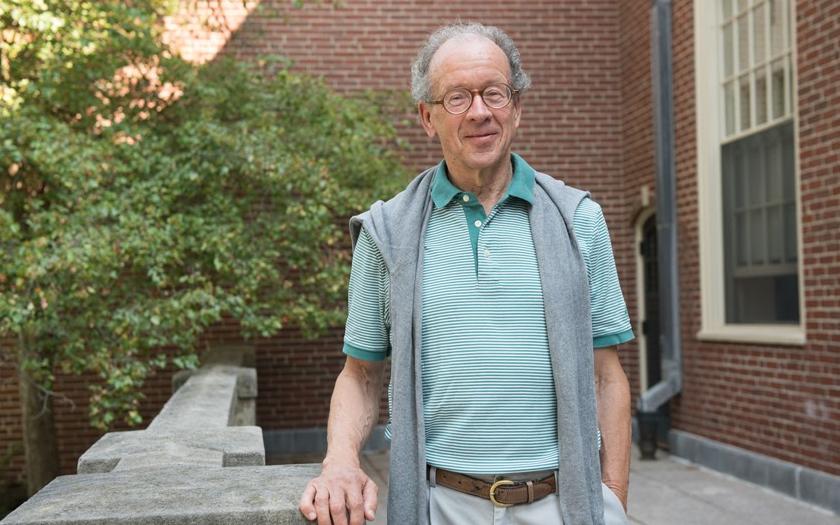August Faculty Spotlight - Arto Nurmikko

Bio
Arto V. Nurmikko, a native of Finland, received his Bachelor of Science and doctoral degrees from University of California, Berkeley, and did postdoctoral work at the Hebrew University (Jerusalem) and Massachusetts Institute of Technology. During his 40+ year tenure at Brown, Prof. Nurmikko has published in several fields (about 400 journal articles), led many multi-institutional research teams, advised federal funding agencies, and lectured worldwide. He serves on advisory boards of several academic and research organizations. Prof. Nurmikko is a Fellow of the American Physical Society, of the Institute of Electrical and Electronics Engineers, and of the Optical Society of America. He has been the recipient of a Guggenheim Fellowship, and elected to the American Academy of Arts and Sciences as well as the Academy of Sciences and Letter of Finland. Among other awards, he was co-winner of the Israel Brain Prize in 2013.
Research
Professor Nurmikko conducts research in neuroengineering, brain sciences, nanophotonics and microelectronics, especially for the translation of device research to new technologies in biomedical, life science, and photonics applications and is part of the Brain Gate team. His current interests include development of implantable wireless neural interfaces, nanoscale neural circuit sensors, compact red/green/blue semiconductor lasers, and high resolution acoustic microscopy. Professor Nurmikko leads an experimental group of approximately 15 scientists, which conducts cross disciplinary research in life and physical sciences. The group includes members from varying backgrounds and expertise such as in physics, in electrical, materials and biomedical engineering, and in neuroscience. Ongoing research areas embrace development of new probes for listening to and well as inducing neuronal activity within brain microcircuits, aiming at interfacing biological information processors (neurons) with microelectronic and optoelectronic implantable microsystems.
1) When did you know you wanted to be a biomedical engineer/researcher?
My pathway is a little more convoluted because I was educated as a physicist and electrical engineer but about 25 years ago the question of maybe bridging over into some biological applications came up. I was already a faculty member here at Brown doing work with lasers and other things that had nothing to do with living things. There was a question of modern tools to probe electrical or magnetic activity in biological material. The nice thing about the interdisciplinary nature of Brown is that I could go around to colleagues and say “I’ve got this toolkit and background. How can that apply to the biology problem that you’re working on?”. Originally, I went to people that were working on sequencing of DNA. Later, I began to talk to neuroscience people, particularly my now close colleague John Donoghue, who was very open minded. I was curious about the brain as computing machinery, and it felt really right to get into this intersection that we know call neuroengineering or neurotechnology.
2) Of all of your publications, is there one you are particularly proud of?
Before my work in biomedical related fields, one particular milestone in my research related to the discovery of compact blue green lasers that are now used in dvd players and hard drives. In my biomedical engineering work, my most notable work might be my most recent. My group has developed wireless neural implants and In the last decade they have through animal studies. They are now under NIH support and making their way to human translation. There are one or two publications that speak to a new device that we think can be a game changer in the field.
3) Have you ever done an experiment that didn’t work?
In purely physical sciences, there is generally less uncertainty in experiments. There’s Schrodinger’s equation of quantum mechanics and the Maxwell equation of electromagnetics, and those two are pretty deterministic. Biological systems, on the other hand, are noisy and messy, and brain circuits are no exception, in fact, it’s amazing that they work as well as they do. They’re comprised of noisy components an electrical engineer would never consider putting together, but perhaps because of the redundancy, somehow these systems still work. So, the short answer is: in the physical sciences experiments fail more often than not, and in the biological sciences experiments fail even more often than that.
4) How do you choose the projects that your group works on?
We’re privileged as research scientists in academia with the freedom to explore. On one level, I start with “crazy” ideas and question. Things like, “Can we communicate brain to brain without speaking?” This seems crazy, but could eventually have significant applications for disabled people. From these larger vague questions, you start to come up with smaller projects that are significantly cross-linked to explore these questions. Each project may have one or two PhD students that are completing their thesis. We do have to remember that these are academic pursuits, and it needs to be possible for students to have a project that they can complete their degree with. Students work in a very cross-disciplinary environment in biomedical engineering and at Brown, especially.
5) What three qualities do you think are most important for a young researcher?
Curiosity, willingness to put in the effort, willingness to share your own ideas.